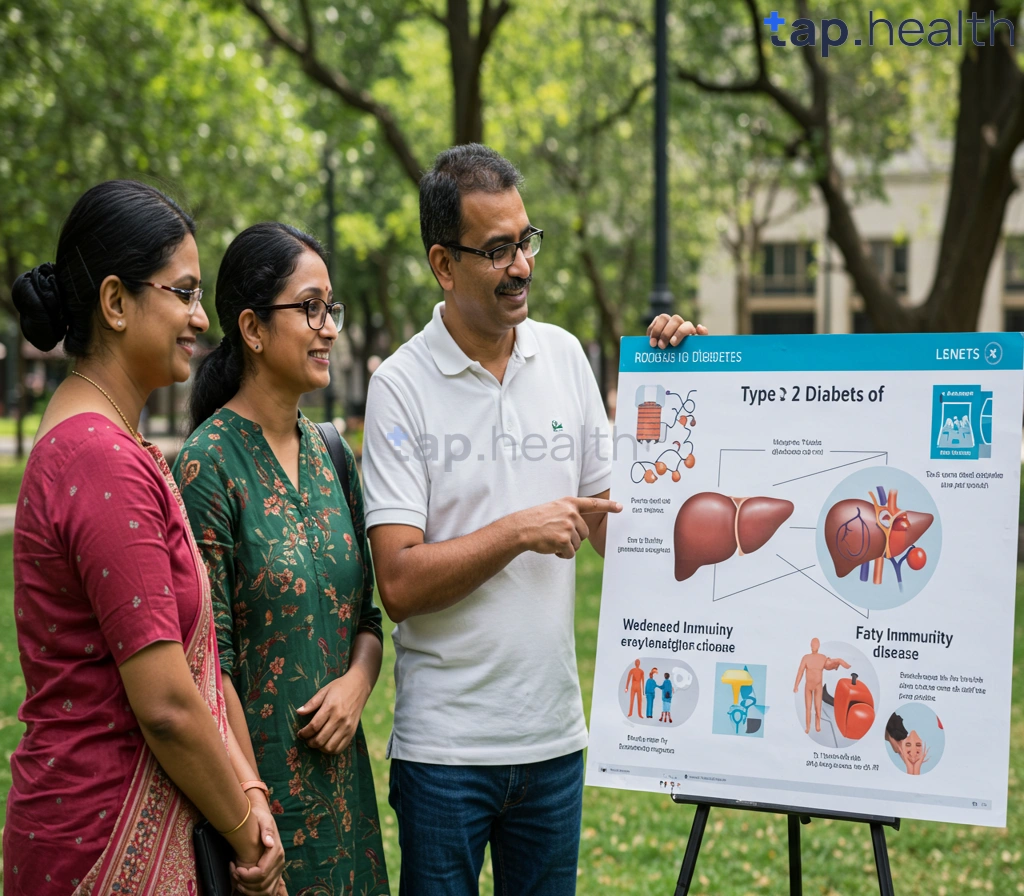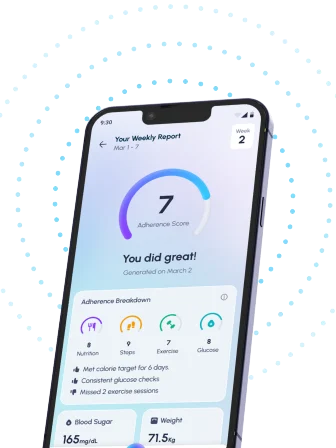Table of Contents
- Understanding HDL and LDL Cholesterol Levels
- What is the Link Between Cholesterol and Diabetes?
- High Cholesterol, Diabetes & Your Risk: A Complete Guide
- Lowering Cholesterol and Blood Sugar: Practical Tips
- Is Your Cholesterol Putting You at Risk for Diabetes?
- Frequently Asked Questions
- References
Managing your health, especially when facing conditions like diabetes, requires understanding the often-confusing world of cholesterol. This is particularly true because high cholesterol significantly increases your risk of heart disease, a major concern for those with diabetes. In this post, we’ll delve into Understanding Cholesterol & Diabetes: HDL, LDL, and Your Risk, breaking down the different types of cholesterol – the “good” HDL and the “bad” LDL – and how they impact your overall health. We’ll also explore practical steps you can take to manage your cholesterol levels and reduce your risk of serious complications. Let’s get started!
Understanding HDL and LDL Cholesterol Levels
Understanding your cholesterol levels is crucial, especially if you live in India or a tropical country and have diabetes. High blood sugar significantly impacts cholesterol management. Studies show that HbA1c levels above 9% are reported in over 30% of diabetes patients, highlighting the strong link between uncontrolled blood sugar and cardiovascular risk. This risk is further amplified by unhealthy cholesterol levels.
Good Cholesterol (HDL) vs. Bad Cholesterol (LDL)
HDL, or high-density lipoprotein, is often referred to as “good” cholesterol because it helps remove cholesterol from your arteries, reducing the risk of heart disease. Maintaining healthy HDL levels is vital for preventing plaque buildup. LDL, or low-density lipoprotein, is “bad” cholesterol. High LDL levels contribute to the accumulation of plaque in your arteries, leading to atherosclerosis and increased risk of heart attacks and strokes. This is especially important to consider in regions with high rates of diabetes, like many parts of India and other tropical areas. For a deeper understanding of what constitutes a healthy LDL level, check out this article on LDL Cholesterol Levels | Tap.Health.
Managing Your Cholesterol in India and Tropical Countries
Lifestyle plays a crucial role in managing cholesterol levels. Adopting a diet rich in fruits, vegetables, and whole grains, while limiting saturated and trans fats, is key. Regular physical activity, even a brisk walk daily, can significantly improve your HDL levels. Regular check-ups with your doctor are essential for monitoring your cholesterol and blood sugar levels, particularly for individuals with diabetes. Discuss your risk factors with your doctor and explore available treatment options to achieve optimal cholesterol levels and reduce your risk of heart disease. Early detection and proactive management are your best defense. If you have diabetes, managing your cholesterol is particularly important, and you can learn more about strategies for doing so by reading How to Manage Cholesterol Levels with Diabetes?.
What is the Link Between Cholesterol and Diabetes?
Diabetes significantly increases your risk of developing high cholesterol, a dangerous combination that elevates the likelihood of heart disease and stroke. This is particularly concerning in Indian and tropical countries where cardiovascular disease is a leading cause of mortality. Understanding the different types of cholesterol is crucial. High LDL cholesterol (often called “bad” cholesterol) contributes to plaque buildup in your arteries, while high HDL cholesterol (“good” cholesterol) helps remove it. Diabetes can disrupt this balance, often leading to elevated LDL and reduced HDL levels. This imbalance puts you at a much higher risk of developing heart complications.
Understanding the Risk Factors
Several factors intertwine to heighten the risk. For example, individuals with diabetes often experience insulin resistance, affecting how their bodies process cholesterol. Additionally, lifestyle choices like poor diet, lack of physical activity, and smoking exacerbate the problem. The alarming statistic that smokers with diabetes face a two times higher mortality rate due to cardiovascular issues underscores the severity of this interplay. In many Indian and tropical regions, dietary habits rich in saturated and trans fats further increase cholesterol levels, adding to the existing risk factors for those with diabetes. This is further complicated by conditions like The Link Between Diabetes and Fatty Liver, which can significantly impact overall metabolic health.
Taking Control of Your Cholesterol
Managing cholesterol and diabetes requires a multi-pronged approach. This includes adopting a heart-healthy diet low in saturated and trans fats, increasing physical activity, and strictly managing blood sugar levels. Quitting smoking is paramount, considering its significant impact on cardiovascular health, especially for those with diabetes. Regular checkups with your doctor are essential for monitoring cholesterol levels and managing diabetes effectively. Prioritizing these steps can significantly reduce your risk of heart disease and improve your overall health and well-being, particularly crucial within the context of the high prevalence of these conditions in our region. Understanding the connection between diabetes and weight management is also critical; you can learn more about this in our blog on Understanding the Link Between Diabetes and Obesity.
High Cholesterol, Diabetes & Your Risk: A Complete Guide
High cholesterol and diabetes are a dangerous combination, significantly increasing your risk of heart disease and stroke. This is especially crucial in India and other tropical countries where these conditions are prevalent. In fact, over 60% of people with diabetes in India also have hypertension, highlighting a critical health concern. Learn more about diabetes in India. Understanding the different types of cholesterol – HDL (good) and LDL (bad) – is key to managing your risk.
Understanding HDL and LDL Cholesterol
High levels of LDL cholesterol, often referred to as “bad” cholesterol, contribute to plaque buildup in your arteries, leading to atherosclerosis. Conversely, HDL cholesterol, or “good” cholesterol, helps remove this plaque. For individuals with diabetes, maintaining healthy cholesterol levels is even more critical due to increased risk factors. Controlling blood sugar is vital in managing cholesterol levels. For practical tips on dietary changes, you might find our guide on How to Control Cholesterol with Diet Chart: Simple & Effective Tips helpful.
Managing Your Risk in Tropical Climates
Lifestyle plays a significant role in managing both diabetes and cholesterol. In tropical countries, dietary habits often include high levels of saturated and trans fats which can negatively impact cholesterol levels. Adopting a heart-healthy diet rich in fruits, vegetables, and whole grains is crucial. Regular physical activity, even moderate exercise, is another essential component of a preventative strategy. As you age, managing diabetes can present unique challenges; Managing Diabetes as You Age: Challenges and Solutions offers valuable insights.
Taking Control of Your Health
Regular check-ups with your doctor are essential for monitoring your cholesterol and blood sugar levels. Early detection and proactive management can significantly reduce your risk of serious complications. Don’t underestimate the power of lifestyle changes in improving your overall health and well-being, especially in the context of high prevalence of these conditions in India and other tropical regions. Seek advice from your healthcare professional for personalized guidance on managing your cholesterol and diabetes.
Lowering Cholesterol and Blood Sugar: Practical Tips
Managing high cholesterol and blood sugar is crucial, especially in India and tropical countries where these conditions are prevalent. For individuals with diabetes, maintaining blood pressure below 140/90 mmHg, or ideally below 130/80 mmHg, is often recommended. Achieving these targets requires a holistic approach encompassing lifestyle modifications and, in some cases, medication.
Dietary Adjustments for Better Cholesterol and Blood Sugar Control
Prioritizing whole foods is paramount. This means incorporating plenty of fresh fruits and vegetables, especially those common in the Indian and tropical regions, like leafy greens, mangoes, and citrus fruits. Limit processed foods, sugary drinks, and saturated fats which are commonly found in many readily available snacks. Focus on incorporating sources of healthy fats like nuts (almonds, cashews), seeds (chia, flax), and avocados. Choosing whole grains over refined carbohydrates helps regulate blood sugar levels more effectively. Remember, portion control is key! For more immediate impact, check out these 10 Tips for Immediate Blood Sugar Reduction.
Lifestyle Changes for Improved Health Outcomes
Regular physical activity is essential. Aim for at least 150 minutes of moderate-intensity aerobic exercise per week, incorporating activities suitable for the tropical climate, such as early morning or evening walks or yoga. Stress management techniques like meditation or deep breathing exercises are also beneficial, as stress can significantly impact blood sugar and cholesterol levels. Adequate sleep is equally crucial for overall health and metabolic regulation.
Seeking Professional Guidance
Regular check-ups with your doctor are vital. They can monitor your progress, adjust your medication if necessary, and provide personalized advice based on your individual needs and circumstances. Don’t hesitate to seek guidance from a registered dietitian or certified diabetes educator for tailored dietary recommendations suitable for your region and lifestyle. Taking proactive steps towards better health management can significantly reduce your risk of long-term complications. Learning about Top 8 Natural Remedies to Improve Blood Sugar Levels can also be beneficial.
Is Your Cholesterol Putting You at Risk for Diabetes?
High cholesterol and diabetes are a dangerous combination, significantly increasing your risk of heart disease and other complications. Understanding the different types of cholesterol – HDL (good cholesterol) and LDL (bad cholesterol) – is crucial for managing your health, especially in regions like India and other tropical countries where heart disease is a growing concern. Maintaining healthy cholesterol levels is paramount for preventing or managing diabetes.
Understanding HDL and LDL Cholesterol
LDL cholesterol, when elevated, contributes to the buildup of plaque in your arteries, leading to atherosclerosis. This process increases your risk of heart attack and stroke – risks already heightened by diabetes. Conversely, HDL cholesterol helps remove LDL cholesterol from your arteries, offering protection. Women with diabetes, in particular, face a heightened risk; research indicates they have a 40% higher risk of heart disease compared to men with diabetes. This emphasizes the critical need for proactive cholesterol management among women with diabetes in India and across tropical regions.
Practical Steps for Cholesterol Management in Tropical Climates
Lifestyle modifications are key to controlling cholesterol levels and mitigating the risk of complications. Prioritize a balanced diet rich in fruits, vegetables, and whole grains, limiting saturated and trans fats common in many processed foods. Regular physical activity is essential, even a moderate amount of exercise can make a significant difference. Consult your doctor or a qualified healthcare professional for personalized advice on managing your cholesterol and diabetes. Regular check-ups and monitoring your cholesterol and blood sugar levels are crucial. They can guide you on appropriate dietary choices, exercise plans, and medication if necessary. Taking proactive steps today will protect your future health. For more information on protecting your heart, you might find Protect Your Heart from Diabetes: 5 Essential Steps helpful. The link between diabetes and other serious illnesses is complex; for example, you may also want to read about the relationship between diabetes and cancer in our article: Does Diabetes Cause Cancer?
Frequently Asked Questions
Q1. What is the relationship between high cholesterol, diabetes, and heart disease?
High cholesterol and diabetes significantly increase your risk of heart disease and stroke. High LDL cholesterol contributes to plaque buildup in arteries, while diabetes disrupts the balance of good and bad cholesterol, often worsening the problem.
Q2. How can I manage my cholesterol and diabetes to reduce my risk of heart disease?
Managing these conditions requires a multi-pronged approach: a heart-healthy diet low in saturated and trans fats, regular physical activity, strict blood sugar control (if diabetic), and smoking cessation. Regular check-ups are crucial for monitoring your levels.
Q3. What’s the difference between HDL and LDL cholesterol, and why are they important?
HDL is ‘good’ cholesterol; it helps remove plaque from your arteries. LDL is ‘bad’ cholesterol; high levels contribute to plaque buildup, increasing your risk of heart disease. Maintaining a healthy balance is key.
Q4. What are some lifestyle changes I can make to improve my cholesterol and blood sugar levels?
Focus on a heart-healthy diet, aiming for lower saturated and trans fats. Incorporate regular physical activity into your routine. If you have diabetes, strictly manage your blood sugar as directed by your doctor.
Q5. When should I see a doctor about my cholesterol and blood sugar levels?
Regular check-ups are essential, especially if you have diabetes or a family history of heart disease. Early detection allows for proactive management, reducing the risk of serious complications. Your doctor can advise on necessary lifestyle changes and potential medication.
References
- Your Guide to Diabetes: Type 1 and Type 2: https://www.niddk.nih.gov/-/media/Files/Diabetes/YourGuide2Diabetes_508.pdf
- A Practical Guide to Integrated Type 2 Diabetes Care: https://www.hse.ie/eng/services/list/2/primarycare/east-coast-diabetes-service/management-of-type-2-diabetes/diabetes-and-pregnancy/icgp-guide-to-integrated-type-2.pdf




